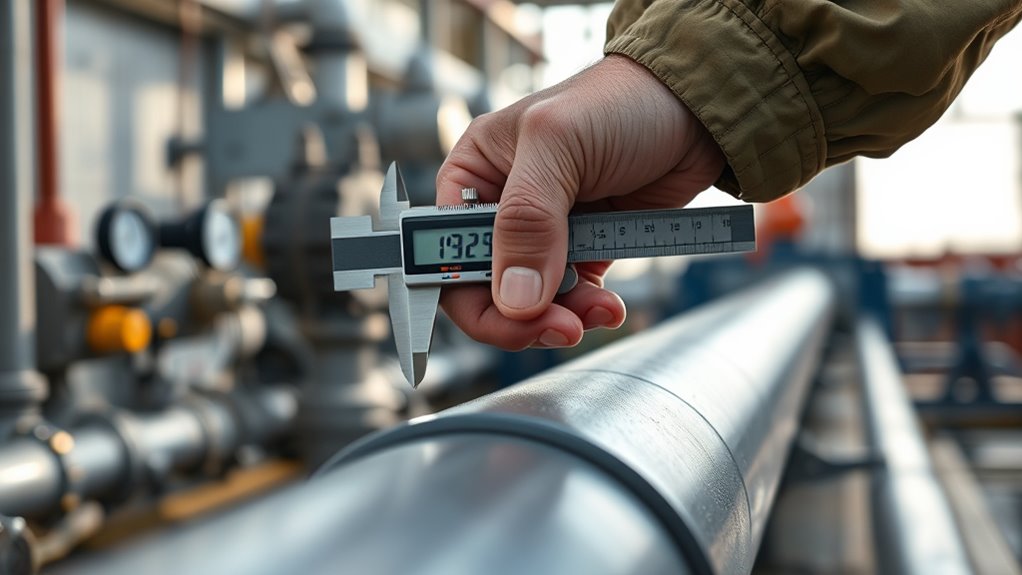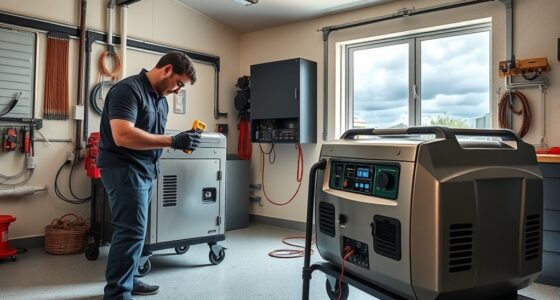To size your natural gas line confidently, start by listing all your appliances and their BTU demands. Measure the longest pipe route from the meter, including fittings, to guarantee accuracy. Use sizing charts that match your load and length, choosing pipes that handle the total demand without pressure drops. Material choice and code compliance are vital for safety and efficiency. Keep learning to master precise calculations and ensure your system is safe and reliable.
Key Takeaways
- Measure the total gas demand by adding all appliance BTUs and include additional length for fittings and elbows.
- Use sizing charts to match effective pipe length and load, ensuring pressure drops stay within safe limits.
- Select appropriate pipe material considering flow capacity, friction, and code compliance, such as black iron or CSST.
- Properly install and test the system with pressure checks and leak surveys to ensure safety and code adherence.
- Regularly inspect, maintain, and document the gas line to ensure continued safe operation and compliance.
Understanding Your Gas Appliances and Their Demands
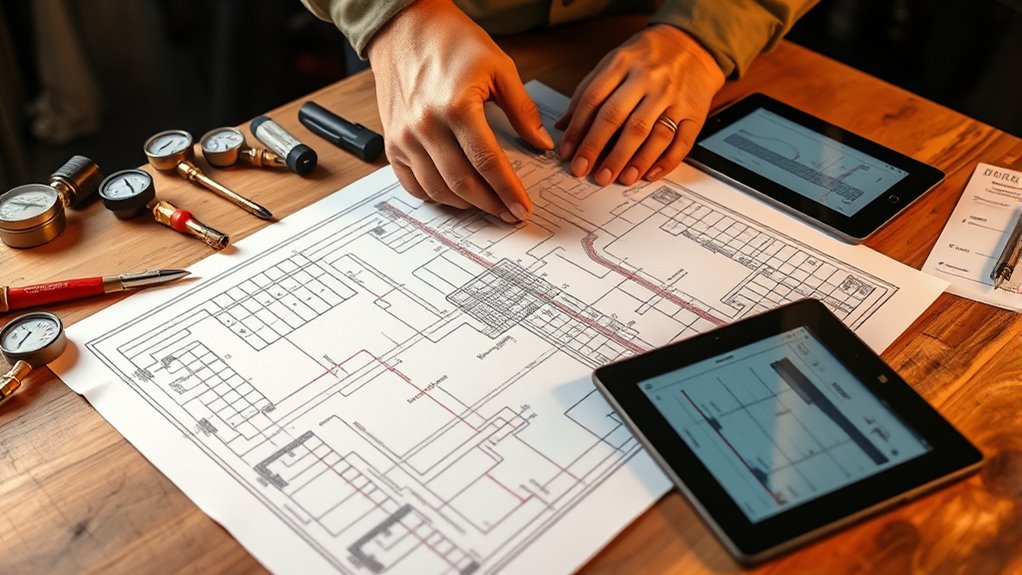
To properly size your natural gas line, it’s essential to understand the different types of appliances you use and their specific demands. Gas ranges and ovens offer instant heat control, precise temperatures, and efficient cooking with multiple burners and convection options for even heat. Natural gas furnaces heat your home faster and more efficiently, often reaching AFUE ratings above 90%. Water heaters heat water twice as fast as electric models, saving you time and money. Gas clothes dryers use less energy and are gentler on fabrics, cutting energy costs annually. Outdoors, gas grills, patio heaters, and fireplaces provide consistent heat without propane refills or ash. Knowing each appliance’s BTU requirements helps guarantee your gas supply is adequate, safe, and efficient for all your household needs.
Calculating the Longest Pipe Run for Accurate Sizing

Accurately gauging the longest pipe run from your gas meter to the farthest appliance guarantees your system is properly sized. This measurement ensures you select the correct pipe diameter to maintain pressure and flow. To do this effectively:
- Measure along the pipe centerline, including vertical and horizontal distances, from the meter outlet to the furthest appliance.
- Include all fittings, valves, and elbows, as pressure drops here impact sizing.
- Use drawings or in-field measurements for complex layouts to find the maximum distance.
- Consider future expansions or added appliances to avoid undersizing.
- Ensure your measurements are precise by double-checking all distances and accounting for any potential obstructions or variations in the pipe route. Additionally, understanding the pressure drop associated with pipe length and fittings helps in selecting the proper pipe size.
This careful measurement helps you reference the right pipe size, balancing safety, efficiency, and cost. Properly determining the longest run prevents pressure issues and ensures reliable gas delivery.
Interpreting Gas Pipe Sizing Charts and Tables
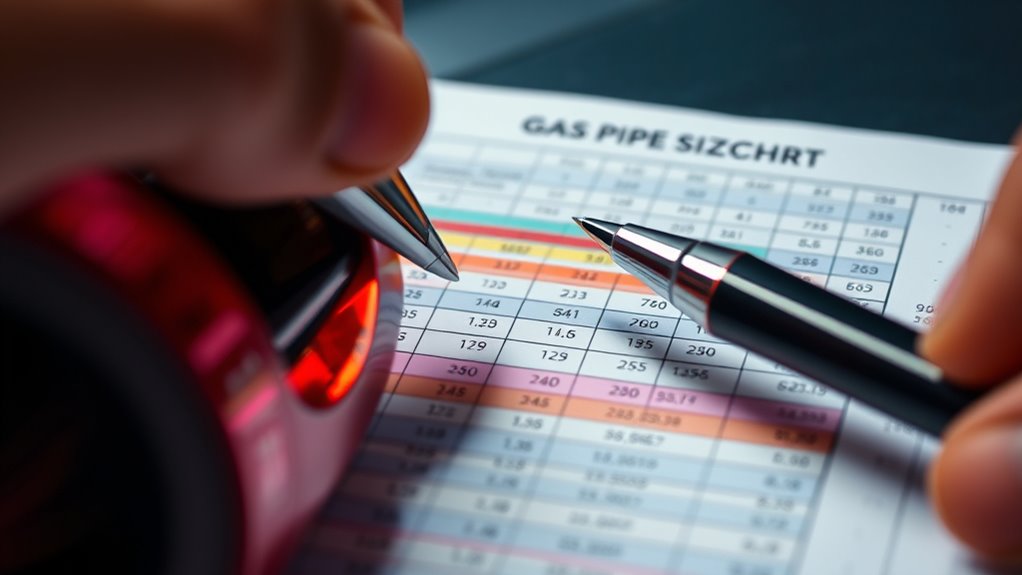
Interpreting gas pipe sizing charts and tables is essential for selecting the right pipe diameter to guarantee proper flow and pressure. You start by matching the longest pipe run with the corresponding row, then find the column that meets or exceeds your total gas demand in MBH or CFH. The intersection indicates the minimum pipe size needed. Remember to add 5 feet per fitting to account for flow resistance. This method ensures accurate system design and prevents undersizing. Proper understanding of commercial production techniques can further optimize your system’s efficiency. Use the table below to visualize how different parameters influence sizing:
| Pipe Length (ft) | Gas Demand (MBH) | Minimum Pipe Size |
|---|---|---|
| 50 | 150 | 1/2 inch |
| 75 | 200 | 3/4 inch |
| 100 | 250 | 1 inch |
| 125 | 300 | 1 1/4 inch |
| 150 | 350 | 1 1/2 inch |
Determining Sectional Pipe Sizes Based on Load and Length

When determining sectional pipe sizes, start by identifying the pipe segment from the gas meter to the most remote appliance. This longest run sets the foundation for sizing. Next, consider these steps:
- Calculate the total gas load by summing all downstream appliances’ demands.
- Measure the actual pipe length and add fitting equivalents to find the effective length.
- Use sizing charts or tables, matching the load and equivalent length, to select the appropriate pipe diameter.
- Verify the chosen size keeps pressure drop within limits and maintains proper velocity.
- Ensure the chosen pipe size aligns with Hyundai Tuning standards for optimal performance and safety.
This process ensures your pipe size accommodates the load without excessive pressure loss. Adjust pipe sizes upstream if loads or lengths change, ensuring safe, efficient gas delivery from meter to appliances.
Considering Pressure, Material, and Code Requirements
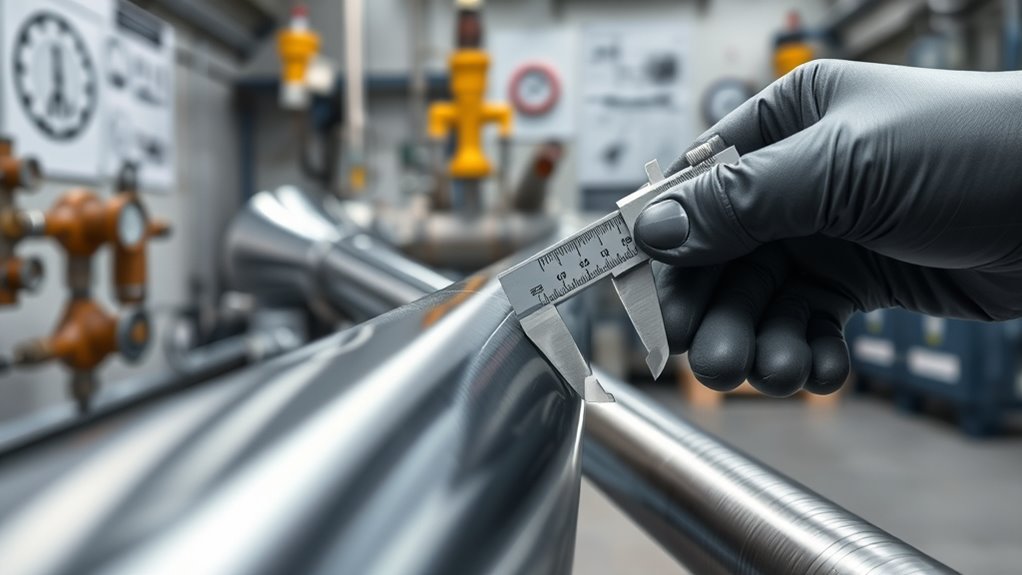
When sizing your natural gas line, you need to consider both the material you choose and the pressure regulations that apply. Different pipe materials have unique friction characteristics that impact flow capacity and size, while pressure drop limits ensure appliances receive adequate gas. Make sure your installation complies with local codes and standards to maintain safety and performance. Additionally, understanding the impact of material selection on overall system efficiency can help optimize your setup.
Material Impact on Sizing
The choice of material substantially influences natural gas line sizing because different materials have distinct friction factors and pressure loss characteristics. Your selection affects flow capacity, pipe diameter, and compliance with codes. For example:
- Black iron pipe has lower friction loss than CSST, allowing smaller diameters for the same flow.
- Schedule 40 steel pipe’s internal diameters vary by size, impacting capacity and sizing decisions.
- Copper pipes, with different roughness, require different sizing considerations compared to steel.
- Material corrosion resistance and longevity influence long-term flow, affecting final pipe sizing choices.
- Material properties, such as roughness and durability, directly impact pressure drop calculations and overall system efficiency. Additionally, understanding the pressure ratings of different materials ensures the system remains within safe operating limits.
These factors, combined with pressure ratings and code requirements, determine your suitable pipe size, ensuring safe, efficient, and compliant gas delivery.
Pressure Drop Regulations
Pressure drop regulations set critical limits to guarantee safe and efficient natural gas delivery, directly influencing pipe sizing and system design. For residential systems, pressure drops are typically limited to 1 PSI from meter to regulator, while manufactured homes require no more than 0.5 inches water column (0.02 PSI). In low-pressure systems, inlet pressures range from 0.25 to 0.5 PSI, with pressure drops often capped at 0.5 inches water column. These limits ensure appliances receive sufficient pressure for proper operation. You must verify that the total pressure drop along the piping doesn’t reduce supply below safe levels. Different codes, like the UPC and manufactured housing standards, specify these limits, which guide pipe sizing and routing. Ensuring proper material selection is essential to meet these pressure standards and maintain system integrity.
Ensuring Compliance and Safety in Gas Line Installation
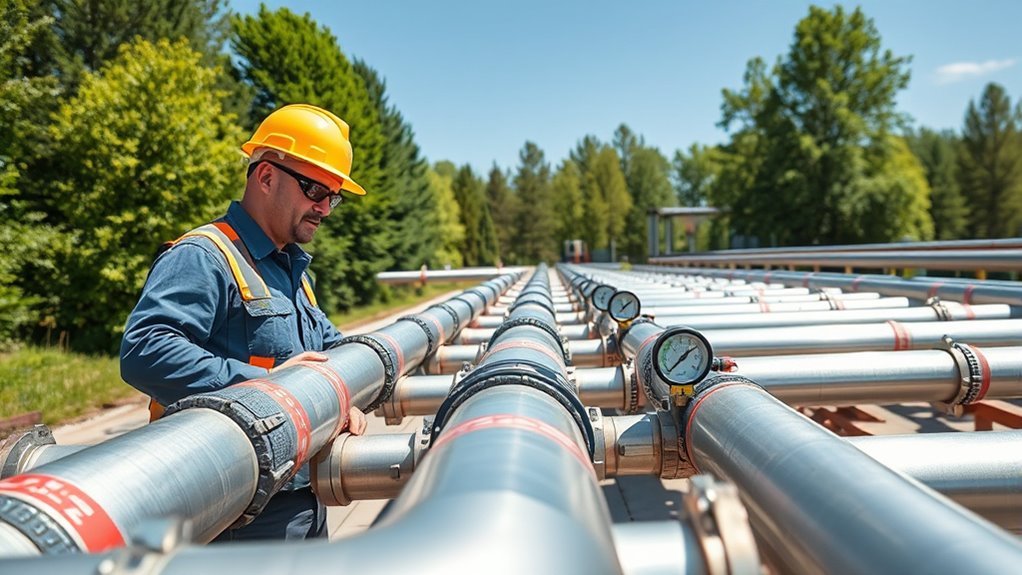
Ensuring compliance and safety in gas line installation requires strict adherence to established standards, regulations, and best practices. You must work with licensed, experienced professionals to guarantee proper installation. Following local building codes, safety regulations, and federal pipeline safety rules (like PHMSA) is essential. Proper material selection and corrosion protection are critical, including using approved pipes and burying underground pipes below the frost line. Regular pressure testing, leak detection, and routine inspections help prevent hazards. Additionally, maintain proper ventilation in areas with gas lines, and ensure physical protection against damage. Here are key steps to ensure safety and compliance: Proper documentation and record-keeping during installation help track compliance and facilitate inspections. 1. Hire qualified personnel for installation and repair 2. Use approved materials with corrosion protection 3. Conduct pressure testing and leak surveys 4. Follow ventilation and physical protection standards
Frequently Asked Questions
How Do I Account for Future Appliance Additions in Pipe Sizing?
To account for future appliance additions, you should increase the total gas load by up to 50%, then size your pipes based on this higher demand. Sum current BTUs, add the future margin, and convert to CFH. Use methods like the Longest Length or Branch Length, including allowances for fittings. Always follow codes and manufacturer guidelines to guarantee your system can handle both current and future loads safely and efficiently.
What Are Common Mistakes to Avoid When Calculating Gas Demand?
When calculating gas demand, avoid treating natural gas as an incompressible fluid and neglecting temperature and pressure variations, which can lead to inaccurate flow and pressure drop calculations. Don’t overlook appliance types, operational hours, or demand variability, as this skews peak demand estimates. Also, make certain you follow relevant standards and codes, accounting for safety, pressure limits, and proper sizing methods to prevent undersizing or oversizing of the pipeline.
How Does Altitude Affect Gas Line Sizing Calculations?
Altitude impacts gas line sizing by reducing gas pressure and density as elevation increases. You must account for pressure drops due to altitude, which can affect flow and appliance performance. Adjust your calculations for changes in volume, pressure, and friction losses, ensuring the pipe diameter can handle the modified demand. Ignoring altitude can lead to undersized pipes, insufficient pressure, and unsafe operation, so always include elevation effects in your sizing process.
What Safety Measures Are Recommended During Installation?
You must follow strict safety measures during installation to prevent disasters. Always hire licensed, experienced professionals and make sure they adhere to local codes. Use approved materials and schedule routine inspections. Test all connections for leaks before use, maintain proper ventilation, and avoid electrical sparks near gas lines. Keep the worksite clear of debris, mark lines clearly, and coordinate with utilities to avoid damage, making safety your top priority.
How Often Should Gas Line Inspections and Maintenance Be Performed?
You should perform gas line inspections and maintenance every 12 to 24 months, depending on your home’s age and usage. Older homes or high-use systems need yearly checks, while newer homes with updated piping can extend to every two years. After major renovations or if you notice any odors or appliance issues, get an inspection promptly. Regular maintenance helps prevent leaks, corrosion, and guarantees your gas system remains safe and efficient.
Conclusion
By understanding your appliances’ demands and accurately calculating pipe sizes, you guarantee safe, efficient gas flow. For example, a homeowner who correctly sized their gas line avoided pressure issues during peak use, preventing costly repairs. Remember, following charts, considering pressure and material, and adhering to codes protect your family and property. With careful planning, you’ll go from zero to confident in your gas line installation, ensuring long-term safety and performance.

